Producer of knitted mattress materials expands its global production capabilities but remains focused on the look, feel and performance of its fabrics

After nearly two years of pandemic-related challenges, Lava Textiles has its eyes focused on the road ahead and the many opportunities for growth that appear on the horizon.
Granted, many obstacles remain before business returns to a more typical footing. Despite the uncertainty, this nearly century-old ticking manufacturer is taking several ambitious steps to strengthen its position as a leading provider of high-quality knitted fabrics for mattresses, pillows and toppers.
For starters, Lava USA, Lava Textiles’ U.S. subsidiary, has begun construction on a 5,000-square-foot showroom set to open in 2022 at its headquarters in York, South Carolina. In early 2022, Lava also will add knitting capacity and expand finishing operations at its plant in Ciudad Juarez, Mexico, where production started last summer. Earlier this year, the company added eight knitting machines in Mexico, four machines in Bogor, Indonesia, and two at its headquarters in Wielsbeke, Belgium, bringing its total number of knitting machines worldwide to 172. The company also has five finishing lines up and running globally.
“Growth in the international market is very important to today’s business,” says Johan Vanwelden, who serves as co-owner and co-chief executive officer of Lava Textiles, along with his son Lucas Vanwelden, who joined the company in 2019. “Having a global presence enables us to offer quicker delivery and serve more customers in emerging markets worldwide. It also has enhanced our ability to expand in existing markets, by giving us alternate sources of product when demand exceeds supply.”
Lava specializes in high-quality knitted fabrics for sleep products with unique, proprietary design twists. Its production process starts with the selection of top-quality yarns, Vanwelden says. These yarns are processed using circular jacquard knitting machines. Once knitted, the fabrics are finished in-house, and, at the end of the production process, “every inch of textile is duly subjected to stringent quality control,” he says.
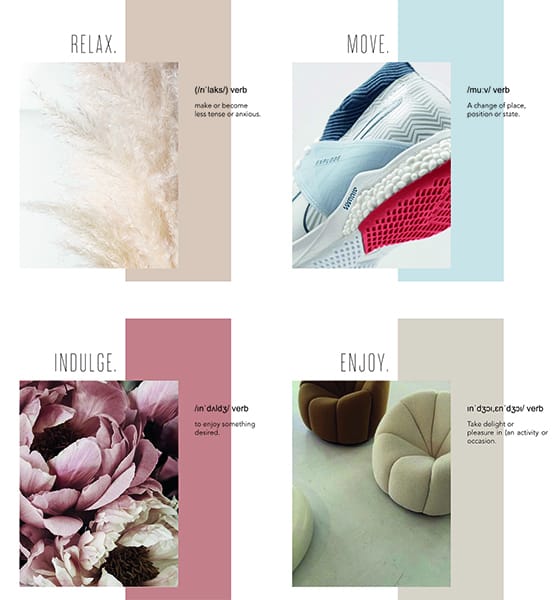
Lava’s design aesthetic for 2021-22 season is Well Being, with four themes: Relax, Move, Indulge and Enjoy.
Deep roots and a global reach
Founded in 1925 by the Lambrecht and Vanwelden families as a producer of knitted undergarments, Lava specialized in knitted fashion fabrics and garments until 1997, when a third generation of the Vanwelden family — Johan and his cousin Marc Vanwelden — became co-owners. At that time, the company began transitioning its business away from the highly competitive world of fashion and into a new arena with more potential for growth: bedding. By 2004, Lava had exited fashion to concentrate solely on the sleep market.
“As the fashion business moved more and more to low-cost producers in southern Europe and Asia, we knew we needed to adjust our business model,” Johan Vanwelden says. “We saw an opportunity to apply our skills and expertise in knitted fabrics to bedding, since most producers back then only made wovens.”
While it took some time to establish relationships in the new sector, Lava’s business steadily grew in its home market of Belgium and neighboring European markets. In 2000, the company began working with a distributor in the U.S. market and, in 2006, it established its own U.S. sales operation. The following year, Lava opened its first U.S. production facility in York. Today, after several rounds of expansions, the facility totals more than 150,000 square feet and employs 130 people.
To support growth in European markets, Lava opened a production facility in Oradea, Romania, in 2011. It expanded the facility in 2014 and 2017, and another expansion is planned for 2022.
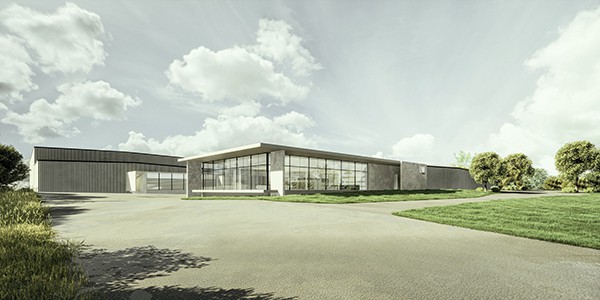
This rendering shows Lava USA’s new showroom building in York, South Carolina, which is slated to open in 2022. The rendering and the showroom design were created by Thomas Vanwelden, an architect and the eldest son of Johan Vanwelden and his wife, Sylvie Vandenameele.
In 2018, Lava added a production facility in Bogor, to support its customers in Asia. Following an expansion of that facility in early 2021, the plant now handles both knitting and finishing operations, providing the same level of quality and service as Lava’s other facilities, Vanwelden says.
The company also has added lamination capacity at several plants, as well as new slitting capacity for fabric rolls up to 39 inches in diameter.
“We design all of our facilities to produce the same level of quality across the board,” he says. “We use the same types of machines, raw materials and procedures so that the end product is the same no matter where it is produced.”
Enhancing service

Today, the United States and Canada account for roughly half of Lava’s total business. Europe, South America and Southeast Asia are the company’s other three core markets.
“We have had growth every year since we transitioned to mattress ticking in 1997,” Vanwelden says. “The pandemic has made it challenging to support this growth, with limited traveling possibilities for management and technicians, and that has delayed some of our projects. But we are very optimistic about our prospects going forward.”
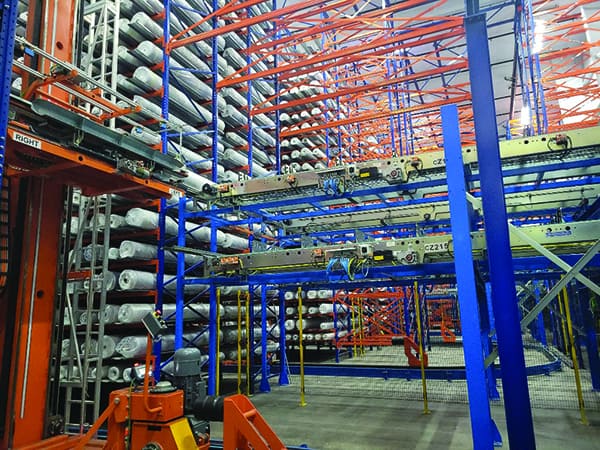
Lava USA added an automated warehouse to its facilities in York in 2018 to speed delivery and reduce damage to fabrics.
Recognizing the key role that service plays in its success, Lava built a new warehouse in York in 2018 with an automated storage and retrieval system. A major investment, the warehouse enables Lava to provide customers with real-time inventory data while improving efficiency and space utilization. The system also reduces both injuries to employees and defects in finished goods because fewer hands touch products.
“Even though the U.S. is a volume market, our customers’ business is still very diverse,” Vanwelden says. “That means that a typical order involves pulling a variety of fabrics off the shelf for loading and shipment. With this new automated system, our ability to handle this task is much faster and more accurate, and potential damage is minimized.”
Unique aesthetic
As part of its business model, Lava offers the same line of fabrics in each of its markets. All the designs originate at its design studio in Wielsbeke, led by Vanwelden’s wife, Sylvie Vandenameele, and her team of seven designers. The team also works closely with Johan Vanwelden, who handles the technical side of many product development projects.
“We draw our inspiration from fashion, architecture, interior design, art and even travel abroad,” Vandenameele says. “We use the inspiration to compile unique mood boards that we then choose as a guide for our new collections. Our designers are motivated every day to perfect each design and to constantly bring each design to a higher level. At Lava, a design is approved only if it is entirely correct from a technical and aesthetic point of view.”

Lava’s designers, based at the company’s headquarters in Wielsbeke, draw their inspiration from trends in fashion, architecture, interior design, art and travel.
The company, Vanwelden says, has developed many of its own knitting techniques. Lava has more than a dozen patents on proprietary knitting techniques. “We also have developed some of our machines together with our suppliers,” Vanwelden says. “That keeps us a little ahead in terms of technology.”
The team in Belgium works closely with Ann Weaver, vice president of sales and marketing for Lava USA, and her group in the United States to stay on top of the latest trends in the market; however, all of Lava’s designs are created by the design team in Wielsbeke.
“This was a very conscious choice,” Vanwelden says. “European design often is a step ahead of the U.S. and conducting all of our design efforts here in Belgium enables us to create a consistent and distinct aesthetic, which our customers appreciate.”
The approach also helps Lava save money on product development because it doesn’t need to fund and support product teams in more than one location.
In developing its fabrics, Lava consults with customers to determine the elements they want to enhance in their mattresses.
“It could be through color, a design idea or a special need they have for their particular clientele,” Vanwelden says. “In most cases, they have found exactly what they want from our vast design library or our latest introductions or finishes. Some have their own ideas and would like designs slightly changed to meet the needs of their unique customer base.”
“Our design team is always ready to listen and work with customers to achieve exactly what they are looking for,” he adds.
Family values
Lava’s culture encourages its employees to “work closely in the care of our customers,” Vanwelden says. “It can be through design ideas, quality, technical innovation or researching trends that are up and coming,” he explains. “Being family owned, we want our employees and customers to feel a part of the Lava team. They are important to us, and we try to keep them informed on the many aspects of what is happening within Lava.”
To make shopping easier for customers when travel still is limited by the pandemic, Lava developed a virtual showroom application that enables its sales representatives to review the company’s newest fabric panels with the customer. In the physical world, Lava is known for its showroom displays featuring large flip-through racks that showcase the latest designs in its line.
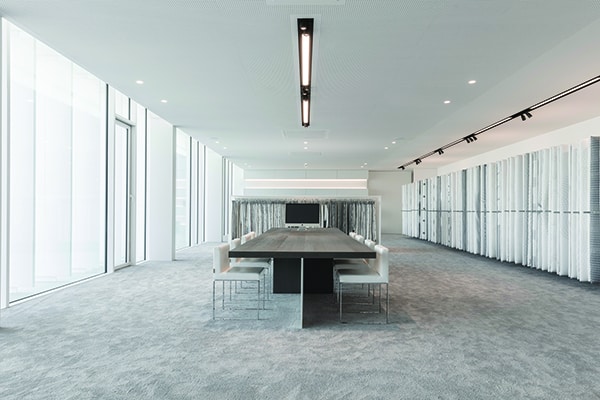
The company’s showroom in Wielsbeke, Belgium, includes a meeting space surrounded by easy-to-view racks of its latest fabrics.
“Coming from the world of fashion, we introduced this idea when we began showing at fabric fairs,” Vanwelden says. “It made us stand out at a time when most companies were only showing small books of new fabrics to their customers, even at shows.”
As an early proponent of knitted fabrics for mattresses and other sleep products, Lava also was a step ahead of many competitors when the boxed bed market took off and demand for wovens, which were less suitable for such applications, began to wane.
“With our well-established knitting capabilities and designs, we were easily able to transition into fabrics for boxed bed applications,” Vanwelden says. “Knitted fabric is more elastic than woven fabric and thus fits better … so it was the perfect match for this new way of packaging and shipping mattresses.”
As boxed beds have gained steam, Lava has seen more interest in knitted border fabrics. “Knitted fabrics previously had been a small part of border business but, with boxed beds, they have become a key design element,” he says.
Vanwelden adds that when shopping, consumers’ first impression of a mattress generally is formed by the fabric. “The cover — especially the border — is the first thing that strikes a shopper’s eyes, and often sets the stage for a sale,” he says.
Current trends
Lava’s current bestsellers include its High Definition and patented Luxe fabrics, as well as its Elas collection.
“The High Definition (line) has an ultra-fine character with an incredibly soft touch,” Vanwelden says. “It has typically been used for the finest lingerie.”
Lava’s Luxe is “a unique fabric that is softer and more appealing than standard double-knit designs,” he says. “The luxurious look is created using different colors in specific areas of volume, hence its name.”
The company developed the Elas line to provide extra elasticity and an easy application on mattresses. With its “beautiful volume and light weight,” this fabric also provides customers with an especially good price point, he says.
Lava sees increased demand for fabrics constructed of specialty yarns with cooling or eco-friendly properties. In Europe, the company offers several finishes with reported antibacterial and virus reduction properties, and ViroClean is one of the latest.
The company’s trend collection for the 2021-22 season is Well Being, with four themes: Relax, Move, Indulge and Enjoy.
“Our focus for this collection is to connect to the mindset of well-being,” Vanwelden says. “Due to the current worldwide situation, the primary goal of consumers is the balance between their minds, bodies and souls. The importance of a restful evening routine, a good night of sleep and recovery became top priority. The most basic act of this self-care revival can be linked to our clients’ beds.”
The collection emphasizes cooling and specialty finishes. It also features seven new colors linked “to the current storyline of people spending more time at home,” Vanwelden says.
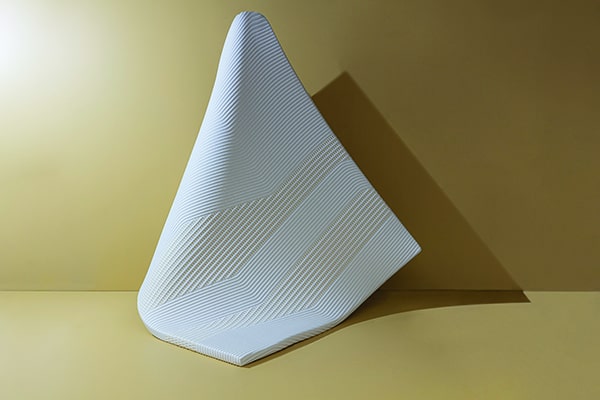
This camel hue, shown here as a contrast to a classic off-white fabric from the line, is part of Lava’s color palette for the 2021-22 season.
With regards to color trends, Lava sees strong interest in blues and grays, along with subtle pops of bright accents, and some renewed demand for beiges and taupes.
Clean white tones with interesting touches of texture or pattern also remain a staple of Lava designs.
“Clients are balancing the warm tones of neutrals with a contrasting mood, such as blues, greens and terracotta shades like our new colors, camel and rust,” Vanwelden says. “We try to keep our designs modest but interesting. After all, we don’t want them to shout, since they are meant to work together with the mattress and the pillow to create the best environment for quality sleep.” •




